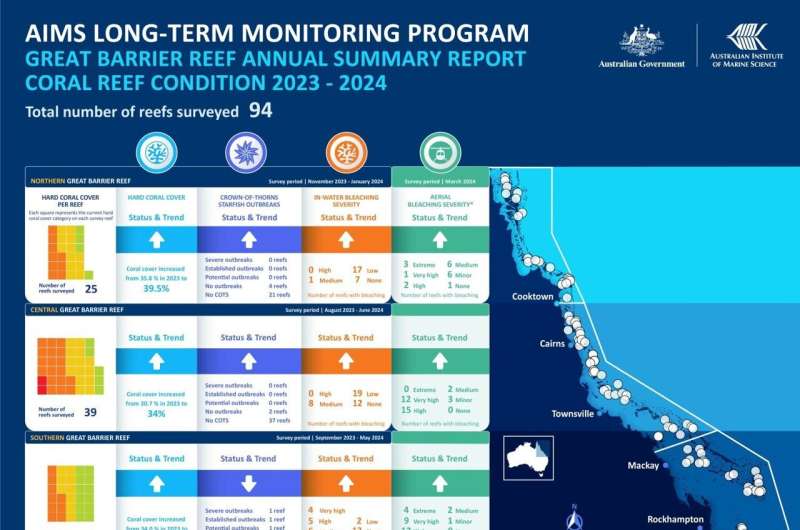This article has been reviewed according to Science X's editorial process and policies. Editors have highlighted the following attributes while ensuring the content's credibility:
fact-checked
trusted source
proofread
New report on Great Barrier Reef shows coral cover increases before onset of serious bleaching, cyclones

Most of the underwater surveys contributing to these findings, published today, were conducted before and during the recent mass bleaching event, one of the most extensive and serious on record, and have not yet captured how many corals survived or died following the bleaching.
Surveys in the Central region were also completed before the passage of tropical Cyclone Jasper in December 2023.
AIMS' Long-Term Monitoring Program (LTMP) leader Dr. Mike Emslie said coral cover increases were a positive sign but did not reflect the potentially destructive consequences of the 2024 mass bleaching event.
"We saw evidence of early onset mortality, particularly in the Southern region, but the full picture of mortality was not yet apparent during this year's surveys," he said.
"While bleached corals are very stressed, they are still alive and are recorded as live coral on our surveys.
"Some types of corals can remain bleached for months, remaining on a knife edge between survival and death. This is why returning and repeating surveys of the reefs in this vast, complex and dynamic system is so important. This year's results serve as a very important reference against which to measure the impacts of the summer's events."
The next (LTMP) survey season recommences in September and will capture impacts on coral cover from this summer's mass bleaching event and the cyclones, with a full assessment complete by mid-2025.
"Climate change remains the greatest threat to the Reef because it drives these mass bleaching events. This most recent one was the fifth such event since 2016. These more frequent and extensive marine heat waves will lead to shortened 'windows' for coral recovery. Recent gains, while encouraging, can be lost in a short amount of time," Dr. Emslie said.
Surveys were conducted at 94 Reefs spread through the Northern, Central and Southern Great Barrier Reef between August 2023 and June 2024.
The Report recorded the following average hard coral coverage:
- Northern region (north of Cooktown)—39.5%, up from 35.8% last year;
- Central region (Cooktown to Proserpine)—34%, up from 30.7%;
- Southern region (south of Proserpine)—39.1%, up from 34%.
The AIMS report finds that small rises in coral cover this year brought the Northern and Central regions to their highest levels in 38 years of monitoring.
The surveys also found that crown-of-thorns starfish outbreaks have persisted on some reefs in the Southern region.
The long term monitoring team surveyed reefs off Townsville after the passage of tropical Cyclone Kirrily in late January, finding evidence of storm damage and declines in hard coral cover ranging from 6% to 10% at Kelso, John Brewer, Helix and Chicken Reefs. Other reefs appear to have escaped with little impact.
AIMS Research Program Director Dr. David Wachenfeld said the regional increases in coral cover are encouraging, showing the Reef's capacity for recovery after reaching their lowest levels within the last 15 years. However, climate change and other disturbances mean this recovery is fragile and Reef resilience is not limitless.
"In many ways the Reef has had some lucky escapes in recent years. The 2020 and 2022 mass bleaching events had levels of heat stress that were not as intense as the 2016 and 2017 events or the 2024 event. Coupled with very few other events causing widespread coral death, that has led to the levels of coral cover increase we have seen," he said.
"But the frequency and intensity of bleaching events is unprecedented, and that is only forecast to escalate under climate change, alongside the persistent threat of crown-of-thorns starfish outbreaks and tropical cyclones."
Aerial surveys undertaken by AIMS and the Great Barrier Reef Marine Park Authority in February and March found bleached corals in the shallows of 73% of reefs surveyed across all three regions.
In recent weeks, AIMS scientists in separate monitoring programs observed substantial mortality in reefs that were particularly hard hit by the 2024 event.
"We are only one large scale disturbance event away from a reversal of the recent recovery. The 2024 bleaching event could be that event—almost half of the 3000 or so reefs that make up the marine park experienced more heat stress than ever recorded," Dr. Wachenfeld said.
"We still don't know how much mortality this event has caused. Our monitoring over the next 12 months will help us to understand how this bleaching event stacks up against the others in the last decade."
AIMS CEO Professor Selina Stead said AIMS was prioritizing research to develop scientific solutions to boost reef resilience under a warming climate.
"Climate change is increasing pressure on reef systems around the world," she said. "The 2024 bleaching event was part of the fourth global bleaching event, announced in April.
"These vitally important ecosystems that millions rely upon need strong greenhouse gas emissions reduction, science-based management of local pressures, and input from multiple fields of research if they are to endure.
"At AIMS we are developing a toolbox of interventions to help reefs adapt to and recover from the effects of climate change."
More information: Long-Term Monitoring Program Annual Summary Report of Coral Reef Condition 2023/24, www.aims.gov.au/monitoring-gre … tion-summary-2023-24
Provided by Australian Institute of Marine Science



















